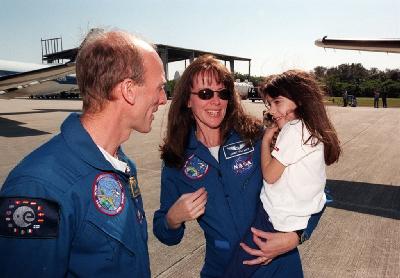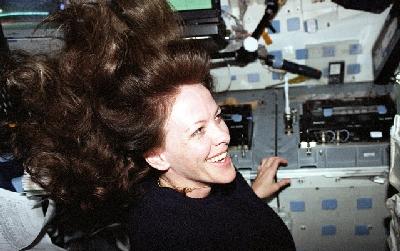April 1, 2004
Astronaut alum had early dream of space
When Janet Kavandi was pursuing her doctoral degree at the UW, she harbored the same career dream she had when she was growing up in rural Missouri. She wanted to be an astronaut.
|
But she didn’t tell that to her colleagues and mentors in the UW Chemistry Department. While the goal was real, she says now, it was so fanciful at the time that it seemed better not to share it with too many people.
In late 1994, four years after receiving her doctorate, the National Aeronautics and Space Administration selected her for the astronaut program. Since then she has logged 33 days in space on three missions, during which she traveled 13.1 million miles in 535 Earth orbits. Her missions have included the final space shuttle mission to the Russian space station Mir and a trip to the International Space Station. She hopes to go back to space again.
Kavandi returned to the UW recently for two seminars, one focusing on her experiences in space and the second in which she told how she has balanced her life as a scientist and astronaut with being a wife and the mother of two children. She said she has never been scared about going into space, particularly because of rigorous survival training all astronauts must face. But she admits to being nervous, particularly for her children.
“You know what can happen, what has happened in the past,” she said, referring to the fatal Challenger and Columbia accidents. “The hardest thing is saying goodbye to them.”
And while time might not have much meaning in her hectic work schedule in space, she said she notes particular times of the day when her kids might be leaving for school or returning home, when her husband might be ending his day as an airline pilot. Her family is never far from her mind, she said.
Even before her career as an astronaut, she had many outside demands on her time. She worked for The Boeing Co. while she was pursuing her doctorate at the UW, working with pressure-sensitive coatings to aid in studying air pressure on surfaces such as airplane wings.
Succeeding on those fronts helped position her for a career with NASA. But being in space, she found, takes some physical adjustments, particularly when gravitational effects are greatly reduced and Earth orbits mean you experience a sunrise or sunset every 45 minutes.
“You lose all your circadian rhythm because it’s light and it’s dark and it’s light and it’s dark, and it all gets messed up,” she said.
But she still finds space travel exhilarating. She particularly enjoys watching the Earth at night, she said, when electric lights outline Europe and North America, and perhaps the most beautiful sight is a string of thunderstorms over Africa, with continuous bright flashing up and down the continent.
Space travel is noisy because fans must operate around the clock to keep air moving through the spacecraft. Because work schedules are so intense during NASA missions, however, sleep might only come in four-hour increments. Kavandi described small, seemingly cramped sleep compartments just large enough for a person to fit into, but she said they actually are quite comfortable and do a good job of blocking out the noise. She, however, doesn’t typically use one.
“I like to sleep on the ceiling — because I can. It’s an interesting experience to wake up in the morning and be looking down at the ground.”
In fact, astronauts just back from the weightlessness of space, when waking up in the morning, can find it difficult for a day or two figuring out which surface is the floor. That’s because in space, it doesn’t matter — with so little gravity, the idea of up, down and sideways loses its relevance.
“It’s very easy for humans to live in space,” she said. “It’s actually harder to come back.”





